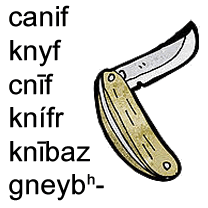
Yesterday I discovered that the French word for penknife is canif [ka.nif], which was borrowed from the Middle English knif / knyf [kniːf] (knife, dagger) [source]. The English word knife comes from the same root.
Knif comes from the Old English cnīf [kniːf] (knife), which was possibly borrowed or influenced by the Old Norse knífr (knife), which comes from the Proto-Germanic *knībaz [ˈkniː.βɑz] (pincers, shears, knife), from the Proto-Indo-European *gneybʰ- (to pinch, nip), from *gen- (to pinch, squeeze, bend, press) [source].
Cnīf was first used in writing in the 11th century. Before then, seax [sæɑ̯ks] was the word for a knife or dagger, which is related to the word Saxon [source].
The French word for knife is couteau [ku.to], which comes from the Old French coutel, from the Latin cultellus (small knife, dagger), a diminutive of culter [ˈkul.ter] (knife, razor) [source], which is also the root of words for knife in Romance languages, the English words cutlass and cutlery, and the Welsh word cyllell [ˈkəɬɛɬ].
Are couteau/cultellus/cyllell/cutlery/cutlass etymologically related to the English word “cut”?
Cut comes from the Middle English cutten, kitten, kytten, ketten (to cut), probably from the Old Norse *kytja, *kutta, from the Proto-Germanic *kutjaną, *kuttaną (to cut), of uncertain origin [source].
My minor nitpick of the day is the lack of annotated aspiration in the IPA transcriptions.
I can’t say much about the others, but I do know that cyllell has the c aspirated. (Welsh stops differentiate in aspiration)
As I said, it’s a minor nitpick and I do appreciate that you’re giving us this post and the IPA for the words on top.
Arth – the c in cyllell is only aspirated when followed by an h, as in chyllell, i.e. the aspirate mutation. Otherwise it’s pronounced /k/.